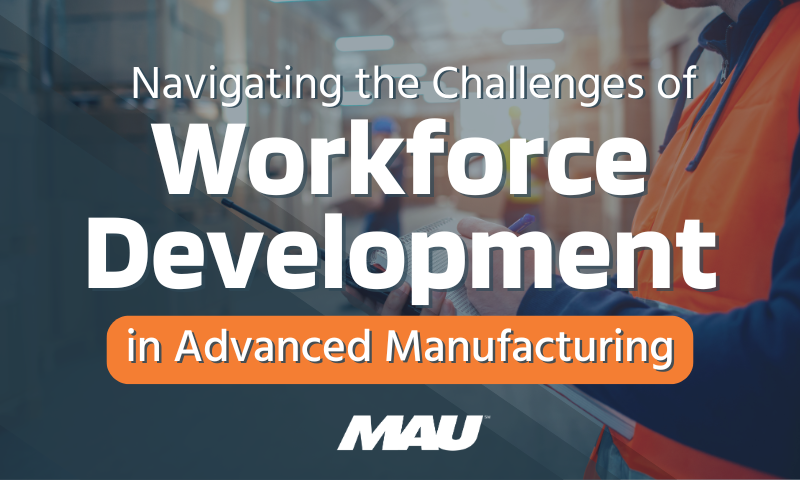As exciting advances in technology, automation, and innovation continue to make their way into the manufacturing industry, it’s clear that some definite trends in manufacturing push companies to reconsider how they operate. From embracing artificial intelligence (AI) and robotics to developing more efficient processes for operations management and supply chain optimization, manufacturers everywhere are exploring different ways of innovating.
This shift is having a widespread impact on almost every sector — from consumer products production to high-end aerospace engineering — as we look towards a future inspired by technologies like additive manufacturing and digital threading.
In this blog post, I’ll outline ten key trends driving the future of manufacturing innovation.
1. Industry 4.0
The fourth industrial revolution, or Industry 4.0, is a new era in the manufacturing sector that combines physical and digital systems to create a highly interconnected and highly automated manufacturing environment. This integration enables the creation of smart factories, where machines and systems work together, continuously exchanging data and learning from each other in real time. As a result, manufacturers benefit from enhanced productivity, greater accuracy, improved decision-making capabilities, and better quality control.
The fourth industrial revolution represents a significant opportunity for manufacturers to transform their operations and stay competitive in an increasingly fast-paced and complex industry. By embracing digital transformation and investing in new technologies such as IoT, AI, and automation, manufacturers can unlock new levels of efficiency and productivity, ultimately maximizing profitability and growth in the future.
2. Additive manufacturing (AM)
Also known as 3D printing, Additive Manufacturing (AM) has revolutionized the manufacturing industry by allowing for greater design flexibility, speed, and cost savings than traditional manufacturing methods.
In addition, AM has the potential to enable highly customizable and complex designs that were previously impossible. By layering materials to form three-dimensional objects, manufacturers can create products with intricate geometries, internal channels, and lightweight structures that were previously not possible using traditional manufacturing techniques.
3. Smart factories
Smart factories use advanced analytics, IoT sensors, and other technologies to optimize production processes, improve safety, and enhance efficiency. This results in a highly connected, data-driven, and adaptable manufacturing environment with the potential to unlock significant benefits for manufacturers.
According to a report by MarketsandMarkets, the smart factory market size is predicted to grow from USD 97.6 billion in 2022 to USD 228.3 billion by 2027, at a CAGR of 18.5% during the forecast period. This demonstrates the growing importance of smart factories in the manufacturing industry.
By incorporating IoT sensors in manufacturing equipment, smart factories can continuously monitor and analyze the production process in real time. This enables manufacturers to quickly identify and address production issues, reducing downtime and improving product quality. Advanced analytics software can identify patterns, predict trends, and optimize production, leading to increased efficiency and cost savings.
4. Artificial intelligence (AI) and machine learning (ML)
Artificial Intelligence (AI) and Machine Learning (ML) are increasingly important in the manufacturing industry, automating maintenance and quality control tasks. One of the key benefits of AI and ML is predictive maintenance, which helps prevent equipment failure and reduces maintenance costs. AI and ML can also improve product quality and efficiency by identifying and correcting defects in real time, increasing customer satisfaction, and reducing waste.
According to Accenture, AI is expected to be integral to manufacturing businesses in the next five years, highlighting the growing importance of these technologies. Manufacturers can optimize production processes, reduce costs, and increase profitability by incorporating AI and ML, helping them stay competitive in a constantly evolving industry.
5. Robotics and automation
Robots and automation are becoming increasingly widespread in the manufacturing industry, offering significant benefits to businesses of all sizes. By incorporating robots and automation into production processes, manufacturers improve productivity, reduce costs, and create new job opportunities.
According to a report by the International Federation of Robotics, robot density in the United States rose from 255 units in 2020 to 274 in 2021. This demonstrates the increasing importance of robotics and automation in the industry. By automating tasks such as material handling, assembly, and inspection, businesses reduce the risk of human error, increase production speed, and improve overall product quality.
6. Sustainability
Sustainability is becoming increasingly important in the manufacturing industry, with many companies adopting practices that focus on reducing waste, maximizing energy efficiency, and minimizing their environmental impact. By embracing sustainability, businesses can reduce their carbon footprint, create cost savings, and strengthen their brand reputation.
By embracing sustainable practices, businesses can reduce their impact on the environment and create strong brand reputations, attract environmentally conscious customers, and save costs by reducing waste and increasing efficiency.
7. Collaborative supply chains
Organizations increasingly collaborate with suppliers and partners in the rapidly evolving manufacturing industry to create more agile and responsive supply chains. This enables them to quickly adapt to changing customer demands, reduce lead times, and improve overall efficiency. Organizations can leverage their partners’ strengths to create more competitive and customer-focused supply chains by working together.
Collaborative supply chains are also essential for managing risk in an uncertain marketplace. By building strong partnerships and creating contingency plans, organizations can mitigate the risks of supply chain disruption and ensure they can continue to meet customer demands even in times of crisis.
8. Augmented reality (AR) and virtual reality (VR)
The manufacturing industry is utilizing technologies such as virtual reality, augmented reality, and collaboration software to provide training and maintenance support to workers. By using these immersive technologies, workers can receive real-time guidance and support, allowing them to work more efficiently and safely.
Virtual and augmented reality allow workers to receive immersive training and practice real-world scenarios without risks. These technologies are also used for on-the-job training, giving workers on-site guidance and assistance, improving efficiency, and reducing the need for extensive and costly classroom training.
9. Advanced materials
Manufacturers are always seeking ways to improve their products and processes, and material innovation is a key area of focus. Manufacturers create new materials offering enhanced properties and benefits from nanomaterials and composites to bioplastics.
Nanomaterials offer improved performance and efficiency; composites are stronger and lighter, while bioplastics are environmentally friendly and made from renewable resources. Manufacturers can create products that offer unique benefits and meet customer needs by investing in these materials. Manufacturers are pushing the boundaries to remain competitive in an ever-evolving industry through material innovation.
10. Data analytics and cybersecurity
Manufacturers generate massive amounts of data from connected devices and equipment, creating opportunities for optimization, efficiency, and innovation. To take full advantage of this data, manufacturers use analytics software to gain insights into production processes, identify areas for improvement, and predict maintenance needs.
However, data also comes with risks, and cyber attacks can result in significant financial losses and damage to the brand’s reputation. Cybersecurity has become a critical focus for manufacturers as they invest in robust data analytics and cybersecurity measures to safeguard their operations.
Investments in cybersecurity measures, such as firewalls, encryption, and threat detection software, can prevent breaches, protect sensitive information, and ensure business continuity. By leveraging data analytics and cybersecurity measures, manufacturers can improve efficiency, reduce costs, and enhance customer satisfaction, all while protecting their intellectual property and staying competitive in a constantly evolving industry.
As the manufacturing sector evolves, several trends drive innovation and shape the industry’s future. From Industry 4.0 and additive manufacturing to the growing use of robotics, automation, and artificial intelligence, the future of manufacturing promises to be more connected, data-driven, and sustainable than ever before.
Overall, the future of manufacturing promises to be a dynamic and exciting era of innovation and efficiency. By remaining agile, embracing new technologies, and prioritizing sustainability, manufacturers can create products that meet customer needs and navigate the industry’s changing landscape. As a staffing and outsourcing company, we are committed to helping our clients navigate these changes by providing access to top talent with expertise in these emerging trends and technologies.





